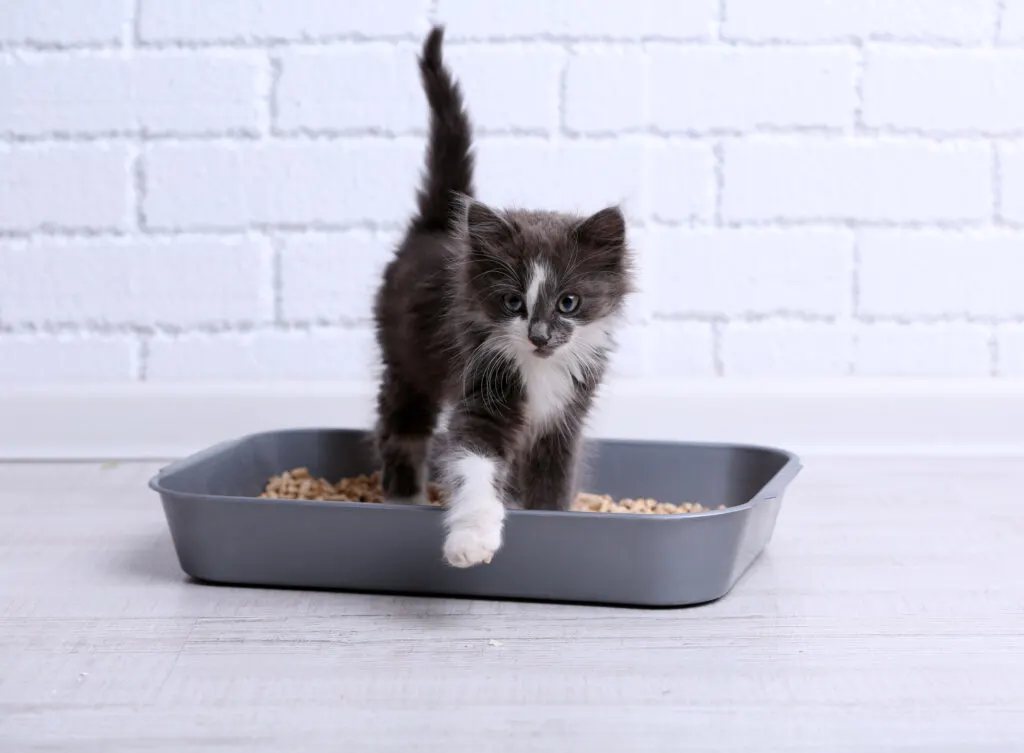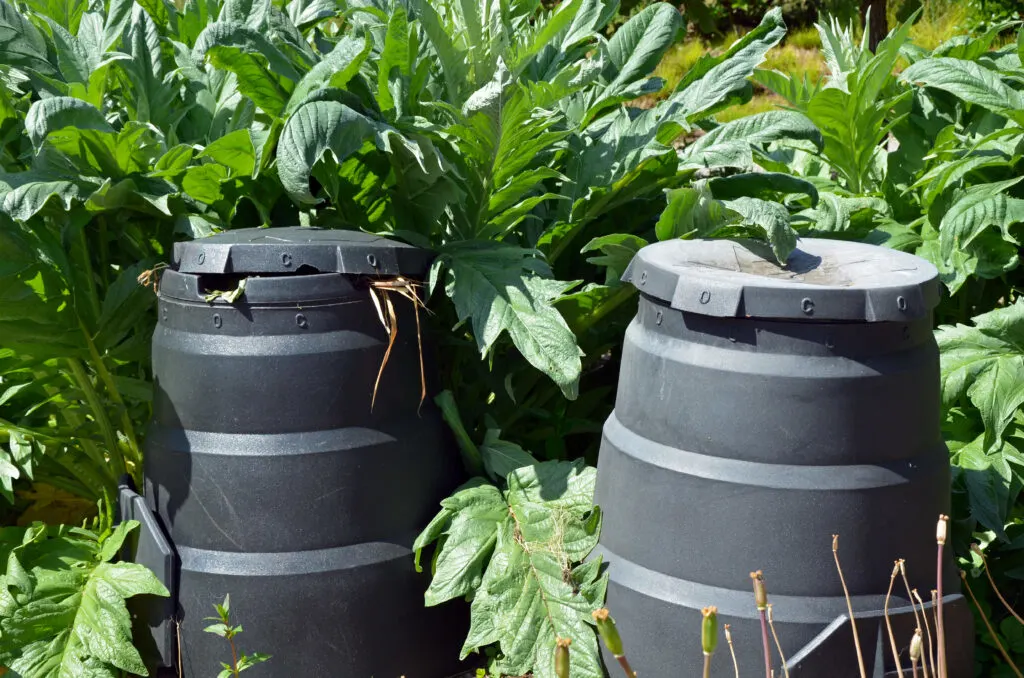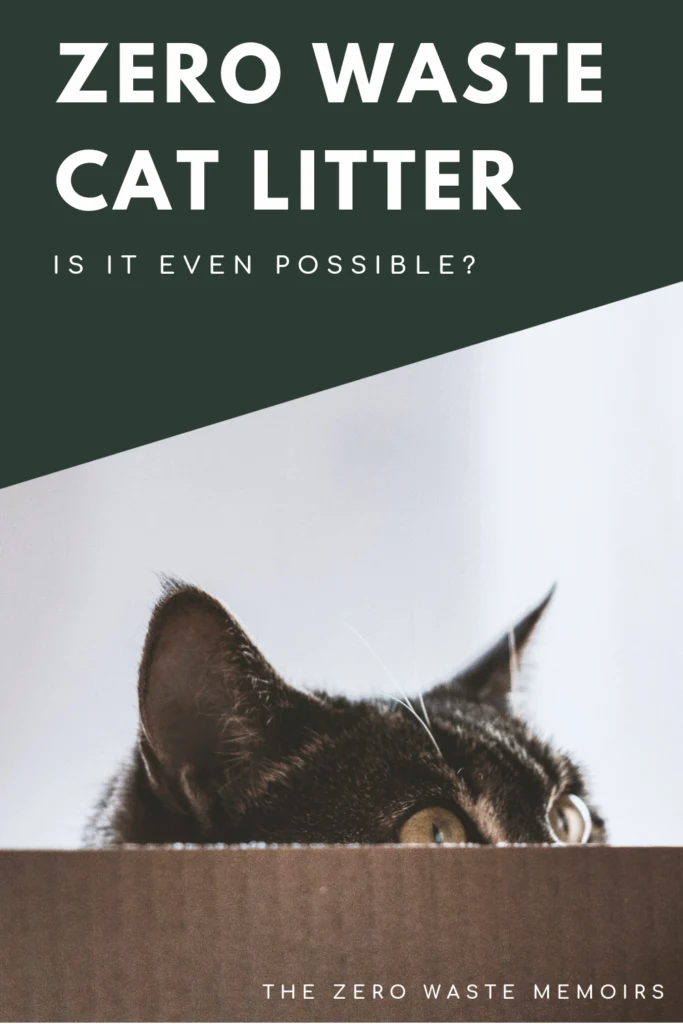Anyone who’s had to clean a litter box knows all too well: cats produce a lot of waste. Not only must cat owners faithfully scoop biological waste, but they must get rid of it, often using liners, bags, and landfill-bound litter in the process.
A zero waste life without pets is challenging enough. With pets involved, it can often feel out of reach. Is it possible to have zero waste cat litter? Not entirely, but we can certainly make strides in the right direction.
This article may contain compensated/affiliate links. See our full disclosure here.
Zero Waste Cat Litter? Is it Even Possible?
No – at least not completely – but that doesn’t mean we shouldn’t minimize the impact of our furry friends. The litter box is the perfect place to start.
From sustainable litter boxes to compostable cat litter, to eco-friendly cat litter disposal – options abound. Your cat likely won’t know the difference, but you can be content knowing your pet’s carbon pawprint will be light.

Choose an Eco Friendly Litter Box
Plastic litter boxes may seem like the most obvious (and often cheapest) choice, but they’re far from sustainable. Besides the fact that they can’t be recycled, and often end up in landfill, think about how often they need replacing due to stains, smells, or getting brittle with age. That’s a lot of litter boxes over your cat’s life!
That’s where eco-friendly litter boxes reign supreme. And a good place to start is with stainless steel and bamboo.
STAINLESS STEEL LITTER BOX
Pros: Durability, Hygiene, Options
Cons: Cost, No Hooded Types

Stainless steel is so durable, you’ll probably never have to replace your litter box again. It’s also incredibly hygienic, meaning your litter box won’t absorb smells, unlike plastic boxes in which smells always seem to linger. A handful of brands give you a few options when it comes to size.
Stainless steel boxes are more expensive than their plastic counterparts, with most models somewhere in the $30-60 range. Considering their durability, this might be worth it.
One workaround is a stainless steel steam pan (used for buffets or catered events) which is significantly cheaper. If your cat likes a hooded box, they’re out of luck; the only option is making a hood of your own. You might also occasionally hear a nails-on-a-chalkboard sound as your cat does his business.
Where to purchase a Stainless Steel Litter Box?
Buy one from Litterbox.com or Amazon (below)
BAMBOO CAT LITTER BOX
Pros: Partial Hood, Still Pretty Durable, Affordable
Cons: Lack of Options, Long-Distance Shipping

One company dominates the bamboo litter box game: Beco. Their bamboo litter box is made from a combination of sustainable bamboo, cornstarch, and rice husks, and it’s the only one readily available online. Unlike steel options, it has a snap-on partial hood and is available in three colors.
The strength of bamboo makes it long-lasting, but it will still scratch and potentially crack in the long-term. A cost of $22 plus shipping makes it cheaper than stainless steel models but more expensive than plastic ones.
With only one model available, there are no size or style options and still no options that are fully hooded. There’s also the environmental cost of shipping from the UK to the US to consider.
Where to purchase a bamboo litter tray?
- Buy Beco tray from the EthicalSuperstore – UK
- Buy Beco tray from Amazon – US
A high level of sustainability makes both stainless steel and bamboo litter boxes great choices. You’re unlikely to find either of these options at your local pet store, but as you’re completing your online order, you can throw in a metal or bamboo scooper to complete your zero waste litter box experience (as for liners, forget them; they’re not needed.)
EXTRA OPTION: LITTER ROBOT
Pros: Self-Cleaning, Durable, Made in USA
Cons: Cost, Limited Litter Options
There are a few automated litter trays on the market, but the Litter Robot is continually voted to be the best. Constructed of recyclable plastics, and industrial-grade components – this is not an item that will need replacing often – if at all. Litter Robot also sell replacement parts and offer an 18-month guarantee (extendable to 3 years), so you can purchase with peace of mind.
But what really makes the Litter Robot an eco-friendly choice is that it uses far less litter than traditional litter boxes. Because it only ‘dumps’ the clumps, the clean litter doesn’t get wasted in the process.
The downside is that it does require clumping litter to work effectively, meaning your choices of eco-friendly cat litter are more limited.
Note – We personally have the Litter Robot and had been using it with clumping clay litter until we realised that wasn’t an eco-friendly option.
In terms of the Litter Robot itself – we love it. With two indoor cats, we went from cleaning two boxes several times a day to only having to empty the waste tray once a week!
Update – We tried the grass seed litter in the Litter Robot but were not happy with how it performed. We’ve heard good things about World’s Best Cat Litter (made from corn kernels) so will be trying that next and will report back!
Where to purchase a litter robot?
- Buy direct from Litter Robot – USA & UK
Ditch Clay for Eco Friendly Cat Litter
Now that you’ve got your litter box sorted, it’s time to think about sustainable and compostable cat litter. Clay – the most common type of cat litter – sounds natural, but it’s far from environmentally friendly. The clay that goes into making litter is mined and processed in a way that destroys habitats and pollutes the environment. The same goes for crystal cat litter.
The good news is that there’s an abundance of biodegradable and sustainable zero waste cat litter choices. Whichever one you choose will depend on which factors are important to you, or – if you have a picky pet – to your cat.
PAPER CAT LITTER
Made from recycled paper compressed into pellets, paper litter is inexpensive, dust-free, non-tracking, and fast to break down. Since it’s not naturally odor eliminating, biodegradable odor controllers are added, but they could still fall short. Paper litter is also not clumping and thus may need to be changed more frequently.
PLANT LITTER: BAMBOO, CORN, GRASS SEED & WHEAT
Pellet bamboo litter is non-tracking and naturally odor eliminating. Those looking for a clumping litter, however, will have to look further.
Kernel-based corn litter is clumping and relatively non-tracking too. However, some have reported that it attracts insects.
Grass seed litter is clumping, naturally odor controlling, and easy to transition to due to its clay-like consistency. It can be messy, however, and it tends to be more expensive. Some cats may also be allergic to this type of litter.
Wheat litter is similar in that it’s clumping, odor eliminating, and good for transitioning, but it can be messy.
NUT LITTER: COCONUT & WALNUT
Coconut and walnut litter both have clumping varieties, are odor controlling, and are easy to transition to due to their finer consistency. Both can also be a bit messy and expensive, and they come with allergy potential.
If odor a bigger concern, go with coconut, which is more naturally odor trapping. If tracking is a bigger concern, go with walnut, which is more low tracking.
WOOD LITTER: PELLETS, CRUMBLES & SHAVINGS
Wood litter varieties are some of the cheapest and most environmentally friendly. They’re also naturally odor eliminating, and many types are somewhat clumping. If dust is a concern, go with wood pellets. If your cat prefers something softer, choose wood crumbles or wood shavings.
When it comes to wood shavings, be sure they are heat treated or kiln dried. If not, your cat will be exposed to potentially toxic oils.
How to Dispose of Eco Friendly Cat Litter
The last step is finding your preferred method of eco friendly cat litter disposal. While some brands claim to be flushable, this will almost certainly strain your septic system. Furthermore, most wastewater treatment systems are not equipped to process cat waste, which contains bacteria and pathogens.
The best options for how to recycle cat litter are burying or composting, but there are caveats.
Don’t bury waste near a water source, and don’t bury it at all if you live near a coastal area. The aforementioned bacteria and pathogens can contaminate water supplies and harm sea life. Don’t bury waste near your garden if you grow your own food, and don’t use cat waste compost in your vegetable garden unless you can ensure that your compost bin is heating to over 145ºF.

If you can’t be 100% sure of this, compost separately and use it only in gardens with non-edible plants. If you live in a coastal area, compost only in a bin or bucket and not in the ground.
Although not the most eco-friendly option, your only other alternative is to bag & toss it. If you’re going to go down this route, try to choose trash bags made of recycled materials or reuse materials you already have that would otherwise end up in the trash (like used packaging) – rather than buying more plastic bags just to dispose of your cat litter.
This is another reason I really rate the Litter Robot, as there is very little waste to dispose of.
As with all things zero waste, use up what you have first. When you’re ready, this guide can help you transition to a more eco-friendly litter box experience. Cats make a big impact on our lives, but they don’t need to make a big impact on the environment.
Have dogs in your life too? Check out this article on zero waste dog poop disposal!
Pin it for later!


Heather
Wednesday 17th of March 2021
Great article, thanks for all your effort that went into the research for the different options. I just have a tiny comment to make about your statement about bagging eco friendly litter in a biodegradable bag and, “Even though it will end up in a landfill, at least it will break down, unlike clay and plastic”
This is where I wanted to clarify. Nothing breaks down in a landfill. Nothing. They are anaerobic environments that maintain everything that goes into them, in the state it ended up in. A scientific excavation of a landfill from the 1950’s has shown that newspapers are still legible, carrot tops still look like carrot tops, potato peelings are still easily recognizable.
Going with a more enviro friendly litter? Absolutely the right choice! Any attempt to keep it out of a landfill within the parameters you have mentioned? Way to go you superstar enviro!
Nadine
Friday 23rd of April 2021
Yes, you're right of course! I've since written about this in other articles, but hadn't thought to come back and update this one - thanks for the reminder!
Leanne
Friday 23rd of October 2020
Does grass seed work well with litter robot? I’ve been searching for eco friendly litter that works almost as good as clay for my litter robot but I can’t find it. I’ve tried corn and walnut and they both didn’t work.
Nadine
Monday 18th of January 2021
Hi Leanne, unfortunately, the grass seed litter that we tried wasn't ideal in the litter robot. We'll be trying the World's Best Cat Litter next and will report back with our findings!
Shane
Thursday 10th of September 2020
Hi Nadine, How did the SmartCat All Natural Clumping Litter go in the Litter Robot? It looks like the packaging on this litter is plastic do you know of a eco friendly cat litter that is not packaged in plastic? Thanks, Shane
Nadine
Monday 18th of January 2021
Hi Shane, I wasn't happy with the performance of the grass seed litter in the Litter Robot. I'm going to try the World's Best Cat Litter next and see how that goes. Will report back!